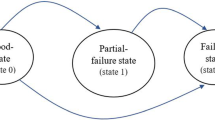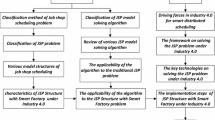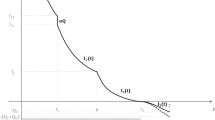Abstract
In this paper we review open queueing network models of manufacturing systems. The paper consists of two parts. In the first part we discuss design and planning problems arising in manufacturing. In doing so we focus on those problems that are best addressed by queueing network models. In the second part of the paper we describe developments in queueing network methodology. We are primarily concerned with features such as general service times, deterministic product routings, and machine failures — features that are prevalent in manufacturing settings. Since these features have eluded exact analysis, approximation procedures have been proposed. In the second part of this paper we review the developments in approximation procedures and highlight the assumptions that underlie these approaches.
Similar content being viewed by others
References
S.L. Albin, Approximating queues with superposition arrival processes, PhD dissertation, Dept. of IE and OR, Columbia University, New York (1981).
S.L. Albin, Approximating a point process by a renewal process. II. Superposition arrival processes to queues, Oper. Res., 32 (1984) 1133–1162.
R.N. Anthony, Planning and control systems: A framework for analysis, Graduate School of Business Administration, Harvard University, Boston (1965).
M. Avriel,Nonlinear Programming. Analyses and Methods (Prentice-Hall, Englewood Cliffs, NJ, 1976).
F. Baskett, K.M. Chandy, R.R. Muntz and F.G. Palacios, Open, closed and mixed networks of queues with different classes of customers, J. ACM 22 (1975) 248–260.
M. Berman and M. Westcott, On queueing systems with renewal departure processes, Adv. Appl. Prob. 15 (1983) 657–673.
D.P. Bertsekas,Constrained Optimization and Lagrange Multiplier Methods (Academic Press, New York, 1982).
D. Bertsimas and D. Nakazato, The departure process from aGI/G/1 queue and its application to the analysis of tandem queues, Working Paper, Sloan School of Management, M.I.T. (1990).
G.R. Bitran and S. Dasu, Approximating non-renewal processes by Markov chains, to appear in Oper. Res. (1990).
G.R. Bitran and S. Dasu, Analysis of∑Ph i /Ph/1 queues, to appear in Oper. Res. (1990).
G.R. Bitran and D. Sarkar, Throughput analysis in manufacturing networks, Working paper, Sloan School of Management, M.I.T. (1990).
G.R. Bitran and D. Tirupati, Multiproduct queueing networks with deterministic routing: Decomposition approach and the notion of interference, Manag. Sci. 35 (1988) 851–878.
G.R. Bitran and D. Tirupati, Capacity planning with discrete options in manufacturing networks, Ann. Oper. Res. 17 (1989) 119–136.
G.R. Bitran and D. Tirupati, Trade-off curves, targeting and balancing in manufacturing networks, Oper. Res. 37 (1989) 547–564.
G.R. Bitran and D. Tirupati, Approximations for product departures from a single server station with batch processing in multi-product queues, Manag. Sci. 35 (1989) 851–878.
G.R. Bitran and D. Tirupati, Approximations for network of queues with overtime, Manag. Sci. 37 (1991) 282–300.
O.J. Boxma, J.W. Cohen and N. Huffels, Approximations of the mean waiting time in anM/G/s queueing system, Oper. Res. 27 (1979) 1115–1127.
O.J. Boxma, A.H.G. Rinnooy Kan and M. van Vliet, Machine allocation algorithms for job shop manufacturing, Econometric Institute Report 9014/A, Erasmus University, Rotterdam, The Netherlands (1990), to appear in J. Intelligent Manufacturing.
A. Brandwajn and Y.L. Jow, An approximation method for tandem queues with blocking, Oper. Res. 36 (1988) 73–83.
E.S. Buffa and R.K. Sarin,Modern Production / Operations Management, 8th ed. (Wiley, New York, 1987).
A.A. Bugalak and J.L. Sanders, Modelling and design optimization of asynchronous flexible assembly systems with statistical process control and repair, Technical report, University of Wisconsin — Madison (1989).
J.A. Buzacott and J.G. Shanthikumar, Models for understanding flexible manufacturing systems, AIIE Trans. 14 (1980) 339–350.
J.A. Buzacott and J.G. Shanthikumar, Approximate queueing models of dynamic job shops, Manag. Sci. 31 (1985) 870–887.
J.A. Buzacott and D.D. Yao, On queueing network models of flexible manufacturing systems, Queueing Systems 1 (1986) 5–27.
J.A. Buzacott and D.D. Yao, Flexible manufacturing systems: A review of analytic models, Manag. Sci. 32 (1986) 890–905.
K.M. Chandy, J. Hogarth and C.H. Sauer, Selecting capacities in computer communication systems, IEEE Trans. Software Eng. SE-3 (1977) 290–295.
K.M. Chandy and C.H. Sauer, Approximate method for analyzing queueing network models of computer systems, ACM Comput. Survey 10 (1978) 281–317.
R.B. Chase and N.J. Aquilano,Production and Operations Management — a Life Cycle Approach (Richard D. Irwin, Homewood, 1989).
H. Chen, J.M. Harrison, A. Mandelbaum, A.A. Ackere and L.M. Wein, Empirical evaluation of a queueing network model for semiconductor wafer fabrication, Oper. Res. 36 (1988) 202–215.
T.C.E. Cheng, Analysis of job flow-time in a job shop, J. Oper. Res. Soc. 36 (1967) 225–230.
G.P. Cosmetatos, Approximate explicit formulae for the average queueing time in the process (M/D/r) and (D/M/r), INFOR 13 (1975) 328–331.
E.V. Denardo and C.S. Tang, Linear control of Markov production systems, Oper. Res. 40 (1992) 259–278.
P.J. Denning and J.P. Buzen, The operational analysis of queueing network models, Comput. Surveys 10 (1978) 225–261.
R.L. Disney and D. Konig, Queueing networks: A survey of their random processes, SIAM Rev. 27 (1985) 335–403.
M.E. Dyer and L.G. Proll, On the validity of marginal analysis for allocating servers inM/M/c queues, Manag. Sci. 23 (1977) 1019–1022.
A.K. Erlang, Solution of some problems in the theory of probabilities of some significance in automatic telephone exchanges, Post Office Electrical Engineer's Journal 10 (1917) 189–197.
A. Federgruen and H. Groenevelt,M/G/c queueing systems with multiple customer classes: characterization and control of achievable performance under nonpreemptive priority rules, Manag. Sci. 34 (1988) 1121–1138.
H.D. Friedman, Reduction methods for tandem queueing systems, Oper. Res. 13 (1965) 121–131.
M.R. Garey, D.S. Johnson and R. Sethi, Complexity of flow shop and job shop scheduling algorithms, Oper. Res. 24 (1976) 117–129.
S.B. Gershwin and I.C. Schick, Modelling and analysis of three stage transfer lines, with unreliable machines and finite buffers, Oper. Res. 31 (1983) 354–380.
S.C. Graves, A review of production scheduling, Oper. Res. 29 (1981) 646–675.
S.C. Graves, A tactical planning model for a job shop, Oper. Res. 34 (1986) 522–533.
R.W. Hall,Zero Inventories (Dow-Jones Irwin, Homewood, 1983).
A. Harel and P.H. Zipkin, Strong convexity results for queueing systems, Oper. Res. 35 (1987) 405–418.
J.M. Harrison, Brownian models of queueing networks with heterogeneous customer populations, in:Stochastic Differential Systems, Stochastic Control Theory and Applications, eds. W. Fleming and P.L. Lions, IMA vol. 10 (Springer, New York, 1988) pp. 147–186.
J.M. Harrison and R.J. Williams, Brownian models of open queueing networks with homogeneous customer populations, to appear in Stochastics (1987).
J.M. Harrison and L.M. Wein, Scheduling networks of queues: Heavy traffic analysis of a simple open network, Queueing Systems 5 (1990) 265–280.
J.M. Harrison and L.M. Wein, Scheduling networks of queues: Heavy traffic analysis of a two-station closed network, Oper. Res. 38 (1990) 1052–1064.
A.C. Hax and D. Candea,Production and Inventory Management (Prentice-Hall, New Jersey, 1984).
R.H. Hayes and S.C. Wheelwright,Restoring Our Competitive Edge; Competing Through Manufacturing (Wiley, New York, 1984).
J.R. Jackson, Networks of waiting lines, Oper. Res. 5 (1957) 518–521.
J.R. Jackson, Jobshop-like queueing systems, Manag. Sci. 10 (1963) 131–142.
A.S. Kapadia and B.P. Hsi, Steady state waiting time in a multicenter job shop, Naval Res. Log. Quarterly 25 (1978) 149–154.
U. Karmarkar, Lot sizes, lead times and in-process inventories, Manag. Sci. 33 (1987) 409–418.
U. Karmarkar, S. Kekre and S. Kekre, Lotsizing in multi-item, multi-machine job shops, IIE Trans. 17 (1985) 290–298.
F.P. Kelly, Networks of queues with customers of different types, J. Appl. Prob. 12 (1975) 542–554.
F.P. Kelly,Reversibility and Stochastic Networks (Wiley, New York, 1979).
L. Kleinrock,Communication Nets: Stochastic Message Flow and Delay (Dover Publ., New York, 1964).
L. Kleinrock,Queueing Systems, vol. 2: Computer Applications (Wiley, New York, 1976).
W. Kraemer and M. Langenbach-Belz, Approximate formulae for the delay in the queueing systemGI/G/1,Congressbook, 8th Int. Teletraffic Congress, Melbourne (1976) p.235–1/8.
P.J. Kuehn, Approximate analysis of general networks by decomposition, IEEE Trans. Commun. COM-27 (1979) 113–126.
C.N. Laws and G.M. Louth, Dynamic scheduling of four station network, Prob. Eng. Inf. Sci. (1989).
A.J. Lemoine, Network of queues — A survey of equilibrium analysis, Manag. Sci. 24 (1977) 464–481.
J.K. Lenstra, A.H.G. Rinnooy Kan and P. Brucker, Complexity of machine scheduling problems, Ann. Discr. Math. 1 (1977) 343–362.
D.V. Lindley, The theory of queues with a single server, Proc. Camb. Phil. Soc. Math. Phys. Sci. 48 (1952) 277–295.
D.M. Lucantoni, New results on the single server queue with a batch Markovian arrival process, Stochastic Models 7 (1991) 1–46.
W.G. Marchal, An approximate formula for waiting time in single server queues, AIIE Trans. 8 (1976) 473–486.
K.T. Marshall, Some inequalities in queueing, Oper. Res. 16 (1968) 651–665.
H. Matsuo and L. Gong, Smoothing production and stabilizing WIP in a production system with yield loss, Working paper, University of Texas, Austin (1990).
G.L. Nemhauser and L.A. Wolsey,Integer and Combinatorial Optimization (Wiley, New York, 1988).
M.F. Nuets, A versatile Markovian point process, J. Appl. Prob. 16 (1979) 764–779.
Neuts, M.F.,Matrix Geometric Solutions in Stochastic Models (Johns Hopkins Univ. Press, Baltimore, 1981).
E. Page,Queueing Theory in O.R., Operational Research Series, ed. K.B. Haley (1972).
S.S. Panwalker and W. Iskander, A survey of scheduling rules, Oper. Res. 25 (1977) 45–61.
H.G. Perros and T. Altiok (eds.),Queueing Networks with Blocking (Elsevier Science, New York, 1989).
V. Ramaswami, TheN/G/1 queue and its detailed analysis, Adv. Appl. Prob. 12 (1980) 222–261.
E. Reich, Waiting times when queues are in tandem, Ann. Math. Statist. 28 (1957) 768–773.
M. Reiser and H. Kobayashi, Accuracy of diffusion approximations for some queueing systems, IBM J. Res. Dev. 18 (1974) 110–124.
M. Reiser and S.S. Lavenberg, Mean value analysis of closed multichain queueing networks, J. ACM 27 (1980) 313–322.
A.H.G. Rinnooy Kan,Machine Scheduling Problems: Classification, Complexity and Computations (Nijhoff, The Hague, The Netherlands, 1976).
M. Rudemo, Point processes generated by transitions of Markov chains, Adv. Appl. Prob. 5 (1973) 262–286.
M. Segal and W. Whitt, A queueing network analyzer for manufacturing,Proc. 12th. Int. Tektraffic Congress, Torino, Italy (1988).
A. Seidman, P.J. Schweitzer and S. Shalev-Oren, Computerized closed queueing network models of flexible manufacturing systems: A comparative evaluation, Large Scale Syst. 12 (1987) 91–107.
K.C. Sevick and I. Mitrani, The distribution of queueing network states at input and output instants, J. ACM 28 (1981) 358–471.
K.C. Sevick, A.I. Levy, S.K. Tripathi and J.L. Zahorjan, Improving approximations of aggregated queueing network systems,Proc. Computer Performance, Modeling, Measurement and Evaluation (1977).
J.G. Shanthikumar, Stochastic majorization of random variables with proportional equilibrium rates, Adv. App. Prob. 19 (1987) 854–872.
J.G. Shanthikumar and J.A. Buzacott, On the approximations to the single server queue, Int. J. Prod. Res. 18 (1980) 761–773.
J.G. Shanthikumar and J.A. Buzacott, Open queueing network models of dynamic job shops, Int. J. Prod. Res. 19 (1981) 255–266.
J.G. Shanthikumar and J.A. Buzacott, The time spent in a dynamic job shop, Europ. J. Oper. Res. 17 (1984) 215–226.
J.G. Shanthikumar and K.E. Stecke, Reducing work-in-process inventory in certain classes of flexible manufacturing systems, Europ. J. Oper. Res. 26 (1986) 266–271.
J.G. Shanthikumar and U. Sumita, Approximations for the time spent in a dynamic job shop with applications to due-date assignment, Int. J. Prod. Res. 26 (1988) 1329–1352.
B. Simon and R. Foley, Some results on sojourn times in acyclic Jackson networks, Manag. Sci. 25 (1979) 1027–1034.
W. Skinner, The focussed factory, Harvard Bus. Rev. (May-June, 1974) 113–121.
M.J. Sobel, Optimal operation of queues, in:Mathematical Models in Queueing Theory, Lecture Notes in Economical and Mathematical Systems, vol. 98 (Springer, 1979).
A.N. Tantawi and D. Towsley, Optimal static load balancing in distributed computer systems, J. ACM 32 (1985) 445–465.
L.M. Wein, Capacity allocation in generalized Jackson networks, Oper. Res. Lett. 8 (1990) 143–146.
L.M. Wein, Optimal control of a two-station Brownian network, Math. Oper. Res. 15 (1990) 215–242.
L.M. Wein, Scheduling networks of queues: Heavy traffic analysis of a multistation network with controllable input, Oper. Res. 40 (1992) S312-S334.
L.M. Wein, Scheduling networks of queues: Heavy traffic analysis of a two-station network with controllable inputs, to appear in Oper. Res. (1990).
W. Whitt, Approximating a point process by a renewal process: A general framework, Bell Laboratories (1979).
W. Whitt, Approximating a point process by a renewal process: Two basic methods, Oper. Res. 30 (1982) 125–147.
W. Whitt, The queueing network analyzer, Bell Syst. Techn. J. 62 (1983) 2779–2843.
W. Whitt, Performance of the queueing network analyzer, Bell Syst. Techn. J. 63 (1983) 1911–1979.
W. Whitt, Approximations for departure processes and queues in series, Naval Res. Log. Quarterly 31 (1984) 499–521.
W. Whitt, Approximations for theGI/G/m queue, to appear in Adv. Appl. Prob. (1985).
W. Whitt, Best order for queues in series, Manag. Sci. 31 (1985) 745–487.
W. Whitt, A light traffic approximation for single-class departures from multi-class queues, Manag. Sci. 34 (1988) 1333–1346.
D.D. Yao and S.C. Kim, Reducing congestion in class of job shops, Manag. Sci. 33 (1987) 1165–1172.
Author information
Authors and Affiliations
Rights and permissions
About this article
Cite this article
Bitran, G.R., Dasu, S. A review of open queueing network models of manufacturing systems. Queueing Syst 12, 95–133 (1992). https://doi.org/10.1007/BF01158637
Received:
Revised:
Issue Date:
DOI: https://doi.org/10.1007/BF01158637




